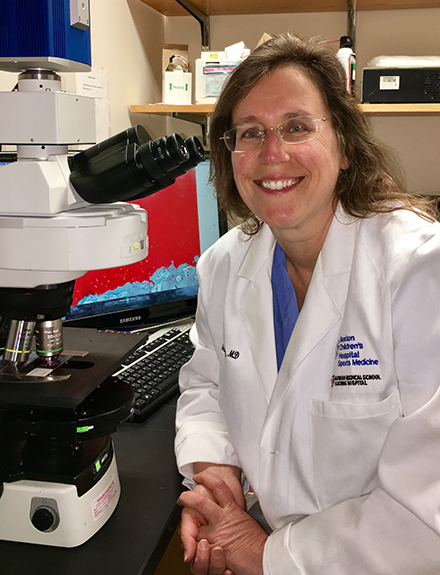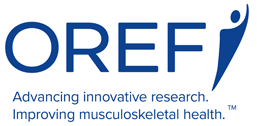

Martha M. Murray, MD
2000 Resident Research Grant
2005 Research Grant
Research Topic
Investigated how two growth factors (PDGF-AB and TGF-ß1) perform within a bioengineered scaffold designed to stimulate production of collagen and regenerate the anterior cruciate ligament (ACL).
Patient Impact
Better ACL repair options that are less invasive and preserve anatomy
Insisting on new possibilities
Two-time OREF grant recipient is unlocking the healing power of the ACL
Sharon Johnson, OREF contributing writer
In the 1980s Martha M. Murray, MD, was a graduate student pursuing a degree in materials science and engineering at Stanford University. Then she learned that a classmate would need surgery and six months of rehab because his torn ACL wouldn’t—couldn’t—heal.
“Everything else in your body heals fine, I thought. Why doesn’t the ACL? Why can’t we sew it back together and get it to restore itself rather than having to replace it?” Dr. Murray recalled asking herself. Those two questions redirected her academic career, from engineering to orthopaedic surgery, and, practically speaking, launched what has become a decades-long search for a new treatment for ACL rupture.
Broad implications, especially for younger patients
Every year in the United States, as many as 250,000 people injure their ACLs, resulting in health care costs estimated at more than $2 billion.1 This debilitating injury is most common among younger, physically active individuals. Although immediate stability can be restored by replacing the ruptured ligament with a tendon graft, for many patients, the results are not long term. The re-tear rate can be as high as 20 percent for teens. Moreover, reconstructed ACLs can lead to early degenerative arthritis and many years of pain and diminished mobility. In fact, up to 80 percent of patients develop arthritis during the 15 to 20 years following ACL replacement surgery.2
Finding a way to heal, rather than replace a ruptured ACL could restore enduring functionality.
Finding a lab and funding
In 1992, having completed medical school and partway through the combined orthopaedic residency program at Harvard University, Dr. Murray was ready to begin formal research. She struck a barter agreement with Myron Spector, PhD, an established investigator. She offered to stain ACL slides for Dr. Spector’s favorite proteins so he could feed more data into his research project in exchange for open access to his lab. As a result, Dr. Murray had a place to work to pursue preliminary studies on ACL healing.
In 2000, Dr. Murray secured the first of two grants from the Orthopaedic Research and Education Foundation (OREF) to support her search for new ways to treat ruptured ACLs. She described the grant as “instrumental...the ramp up that first really steep step."
Step one: developing and testing a bioengineered scaffold
The initial study looked at how two growth factors, PDGF-AB and TGF-ß1, perform within a bioengineered scaffold designed to stimulate cell proliferation and production of collagen by ACL cells, which are two biologic requirements for successful ligament healing.
Procedurally, the study got off to a quick start since the methodology relied on protocols and techniques that Dr. Murray had previously developed and validated—histologic and immunohistochemical protocols as well as scaffold manufacture and tissue and cell culture techniques.
Results showed that both growth factors tested stimulated ACL cell proliferation and collagen production. However, PDGF-AB produced more collagen. The next phase of work could move forward—provided funding could be obtained.
Step two: optimizing the scaffold
In 2005, Dr. Murray was awarded a second OREF grant to do additional testing of the bioengineered scaffold in animal models. Specifically, this study sought to determine whether the use of a scaffold to deliver a biologic therapy to an injured ACL would work in a knee.
For the first time, Dr. Murray’s team was able to show that repair and regeneration can be accomplished in a partial tear of the ACL. This significant finding that not only propelled the ensuing 15 years of research, but also allowed Dr. Murray to secure five National Institutes of Health (NIH) R01 grants totaling more than $8 million. This research focused on improving the understanding of the biologic response of the ACL to injury and surgery with a goal of translating those discoveries into a new surgical technique for ACL injuries.
New BEAR technique
Through their NIH-funded studies, Dr. Murray, in collaboration with Braden Fleming, PhD, developed a new technique for ACL surgery called Bridge-Enhanced® ACL Repair (BEAR). The technique uses stitches and a bridging scaffold—a bioengineered sponge injected with the patient’s blood—to stimulate healing.
The BEAR® technique offers several advantages compared to conventional ACL reconstruction. Most notably, unlike reconstruction techniques, the repair eliminates graft harvesting and preserves the remaining ACL tissue. Current clinical trials under way at Boston Children’s Hospital Orthopedic Center have enrolled 120 patients. Patients who had at least 50 percent of the length of the ACL still attached to the tibia were eligible to participate. Now the team and the U.S. Food and Drug Administration are following these patients closely through their recovery.
Dr. Murray and her research team are one year into this 2-year, randomized clinical trial, which will provide proof of concept. To date they have studied only patients at Boston Children’s Hospital under 35 years of age, but they recently opened a new trial (BEAR® III) and plan to add Rhode Island Hospital, an adult hospital, to that trial later this year, which will extend participation to all patents over 12 years of age. In addition, Kurt P. Spindler, MD, will be heading a fourth multicenter trial for which he has applied for NIH funding. According to Dr. Murray, if they are able to obtain FDA and IRB approvals for the fourth trial, it would allow patients at sites beyond the Northeastern United States to participate, and they will also be able to apply for a Conformité Européene (CE) mark.
Dr. Murray made it clear she won’t be satisfied until patients with ruptured ACLs have new choices. “There’s going to be something better, and we should be working toward it,” she said.
More clinician researchers needed to advance care
As Dr. Murray and her research team oversee the BEAR trials, they are simultaneously pursuing early-stage investigations into rotator cuff healing and treatment of post-traumatic osteoarthritis. Although she sees great promise for advances in orthopaedic care, she is concerned that the specialty needs to invest in more surgeon-scientists.
“The number of orthopaedic surgeons who are funded by the NIH has come way down in the last decade,” she said. “Any small thing we can do to save just one clinician-scientist is critically important. The big improvements in orthopaedic practice are going to come through research done by teams that include a surgeon-scientist. If we don’t encourage surgeons who want to do research through things like supporting OREF, that means the research is going to come from people who never shake hands with our patients.”
Sharon Johnson is a contributing writer for OREF. She can be reached at communications@oref.org
1. Centers for Disease Control and Prevention https://www.cdc.gov/injury/erpo/icrc/2009/1-r49-ce001495-01.html
2. Enhanced ACL Repair (BEAR) vs. ACL Reconstruction for Surgical Treatment of ACL Injuries, Boston Children’s Hospital Orthopedic Center
